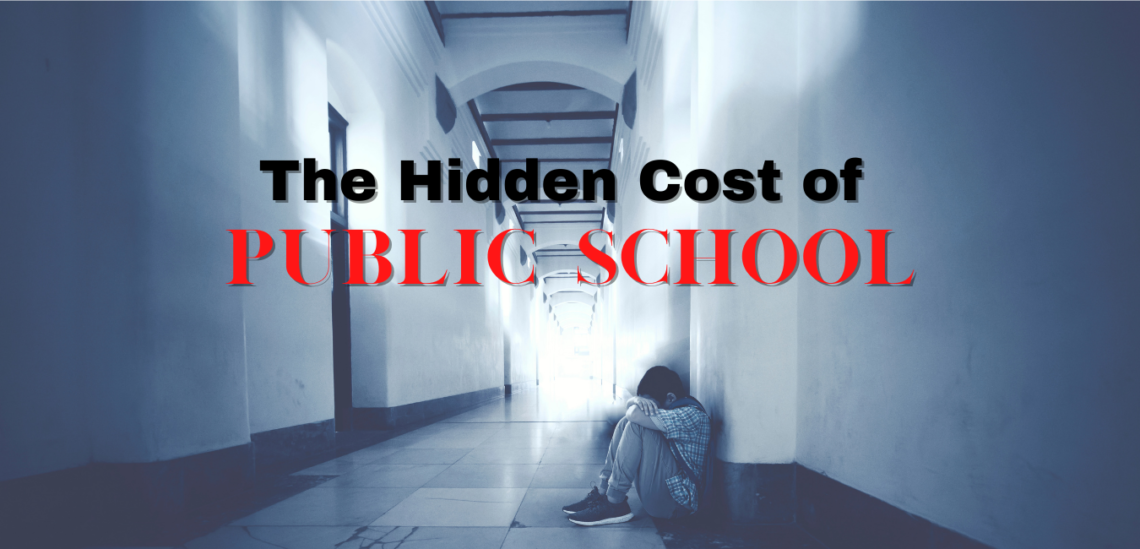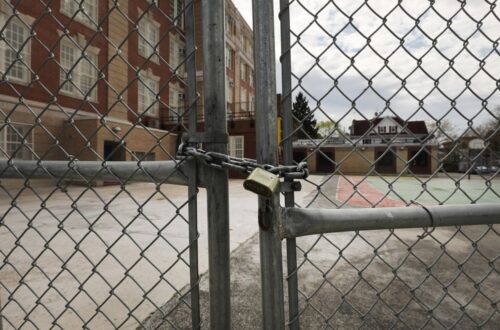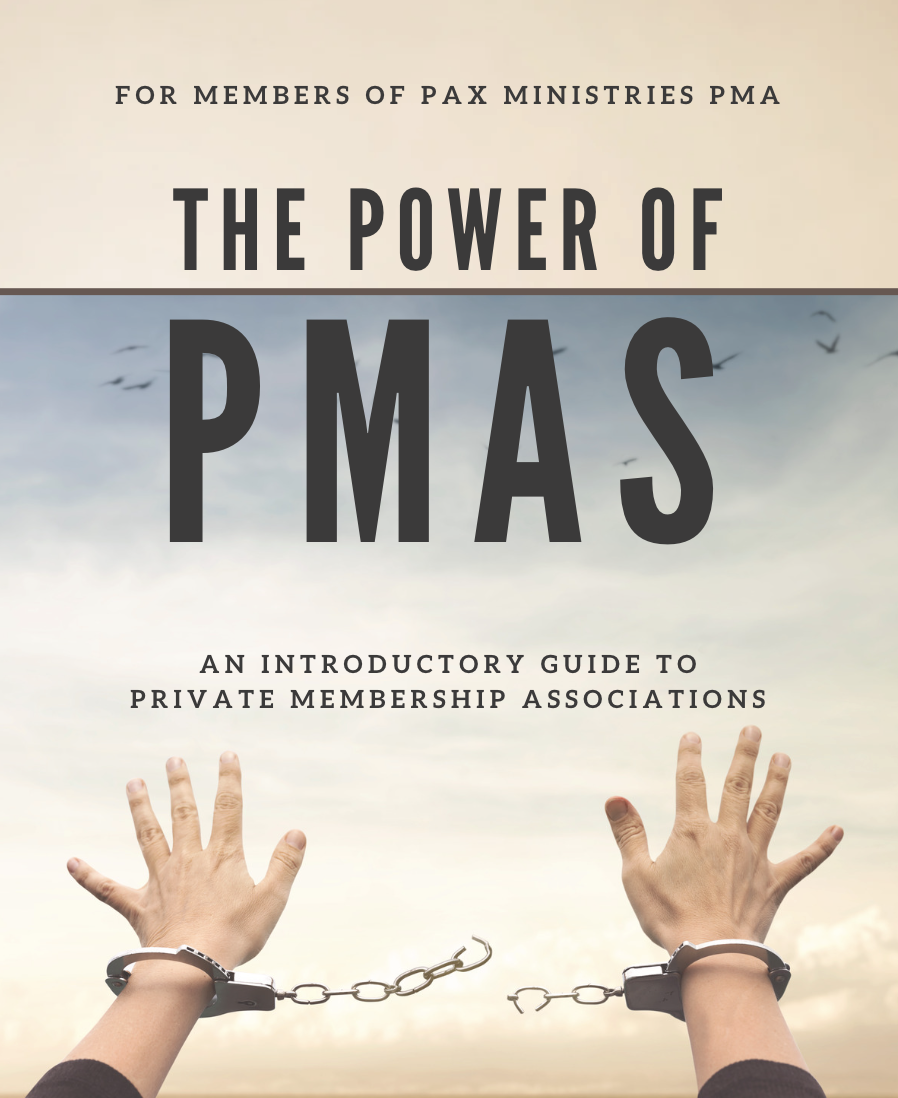
The Hidden Cost of Public School
A free public education is anything but free or public. However, most people are not aware of the hidden costs of public school which are actually the most detrimental.
Public school costs us: emotionally, physically, personally, relationally, and spiritually.
Emotional Cost
Public school has an emotional cost. Many studies (see below) have shown that attending school has a negative emotional impact on students. We may tend to downplay the impact of anxiety and depression on our children, but the reality is clear. No one escapes unscathed.
Most if not all of us have experienced “test anxiety” at one point or another. Why is that even a thing? How have we come to give so much weight or importance to filling in a bunch of bubbles on a piece of paper as though that paper holds any intrinsic meaning or significance in this life?

Children also struggle with bullying, depression, cliques, gossip, slander, libel, loneliness, anxiety, fear, frustration, high levels of stress, feelings of inadequacy, feelings of failure, etc.
The emotional toll of spending our days and our years wrapped up in a system that functions entirely off of bribes and punishment leaves even the “best” of students emotionally scarred.
Physical Cost
Mental health experts readily agree that our emotional health also impacts our physical health. Emotional stress manifests itself as:
- headaches
- low energy and fatigue
- insomnia or other sleep issues
- wetting the bed
- upset stomach, including nausea, vomiting, constipation or diarrhea
- muscle aches and pains
- chest pain
- frequent colds and infections
- grinding teeth
- obesity and/or eating disorders
- skin and hair problems, such as acne, psoriasis, eczema, hair loss
There is a physical cost to our bodies for remaining in stressful environments (like most public schools) for extended periods of time.
Personal Cost
Public schools are designed during the industrial era to produce good “worker bees.” They were never designed to meet the individual needs of our children.

Each human being has his or her own unique passions and interests. Those are largely lost upon entrance in a formal schooling system.
A curriculum now dictates what each child should learn and when with no regard to the individual’s unique gifts and talents. We shuffle them through the system year after year based on arbitrary age requirements regardless of a child’s individual ability. This is exactly how the public school system can produce 18 year old graduates who do not know how to read or perform basic math functions.
Imagine if each child was free to explore his or her unique and individual passions from a young age? What if we did not force children to learn a multitude of random (mostly useless) facts, but encouraged them to explore, create, ponder, analyze, and problem solve issues within their fields of interest?
I often wonder what would have become of my life if I had been given the freedom to do just that – to devote my hours and my days to something that I really loved rather than being forced to become a “jack of all trades,” and an expert of none.
Public school has a personal cost – we are losing the personal identities behind our children as individuals in favor of conformity.
Relational Cost
Many people often say that a parent should never be a friend. I never quite understood that statement. I mean, why not?
A friend is someone that you go to in times of trouble, someone you enjoy being with, someone who knows you (often better than you know yourself).
A friend is someone you can laugh with and cry with.
A friend will have your best interest at heart.
A friend will have your back and be there for you.

Why would I not want to have that kind of relationship with my children?
However, from a ripe young age of 5 (and for many children, even as young as 6 weeks old), children are torn from their parents and forced to spend hours upon hours, days upon days and years upon years with strangers – hours and days and years that we will never be able to get back.
While it is wonderful to be able to expose our children to other cultures, beliefs, values, and people, it often comes at a cost to our relationship with them.
We cannot expect our children to spend the majority of their lives away from us, as their parents, and expect to have a thriving, connected relationship with them.
While the focus should definitely be on quality over quantity, there is something to be said about the amount of time that we are able to spend with our little ones.
If most parents work a traditional 9 to 5 job, then let’s assume they arrive at home by 5:30 PM – just in time to start making dinner, tidy up a bit, help with homework and then before long, it’s time for bed. How much quality time are we really able to spend as a family?
The relational cost of public school just may not be worth it.
Spiritual Cost
While I hope that this blog serves to encourage people of many different faiths and belief systems, I am writing this as a Christian from a Christian worldview.
Public school does indeed have a very real spiritual cost.
Many of the values and beliefs of teachers and administrators are in direct conflict with the Word of God – not to mention the plethora of beliefs encountered by the other students.
While I believe that it is important to expose our children to a wide variety of beliefs and opinions, there is also wisdom in knowing when and how to expose our children to those conflicting beliefs.
It is important that we can process those views and beliefs together with our little ones rather than simply expecting them to figure it all out on their own.
Conclusion
Public school is not as free as we would like to think that it is. Every public school has real and perceived costs that it is important to be aware of.
But the important thing to remember is that you are not stuck. Every educational model has pros and cons, advantages and disadvantages.
If you are not happy with the options in your neighborhood, then count the cost and invest your time and energy into creating a new future for yourself and your family.
References
- Adams J. W., Snowling M. J., Hennessy S. M., Kind P. (1999). Problems of behaviour, reading and arithmetic: assessments of comorbidity using the strengths and difficulties questionnaire. Br. J. Educ. Psychol. 69 (Pt 4), 571–585. 10.1348/000709999157905 [PubMed] [CrossRef] [Google Scholar]
- Adrian M., Miller A. B., McCauley E., Vander Stoep A. (2016). Suicidal ideation in early to middle adolescence: sex-specific trajectories and predictors. J. Child Psychol. Psychiatry 57 645–653. 10.1111/jcpp.12484 [PMC free article] [PubMed] [CrossRef] [Google Scholar]
- Akos P., Galassi J. P. (2004). Middle and high school transitions as viewed by students, parents, and teachers. Prof. Sch. Counsel. 7 212–221. 10.1007/BF02088419 [CrossRef] [Google Scholar]
- Akos P., Rose R. A., Orthner D. (2015). Sociodemographic moderators of middle school transition effects on academic achievement. J. Early Adolesc. 35 170–198. 10.1177/0272431614529367 [CrossRef] [Google Scholar]
- Alspaugh J. W. (1998). Achievement loss associated with the transition to middle school and high school. J. Educ. Res. 92 20–25. 10.1007/s10935-008-0153-9 [CrossRef] [Google Scholar]
- Alspaugh J. W., Harting R. D. (1995). Transition effects of school grade-level organization on student achievement. J. Res. Dev. Educ. 28 145–149. [Google Scholar]
- Anderman E. M. (1998). The middle school experience: effects on the math and science achievement of adolescents with LD. J. Learn. Disabil. 31 128–138. 10.1177/002221949803100203 [PubMed] [CrossRef] [Google Scholar]
- Anderman E. M., Midgley C. (1997). Changes in achievement goal orientations, perceived academic competence, and grades across the transition to middle-level schools. Contemp. Educ. Psychol. 22 269–298. 10.1006/ceps.1996.0926 [PubMed] [CrossRef] [Google Scholar]
- Anderson L. W., Jacobs J., Schramm S., Splittgerber F. (2000). School transitions: beginning of the end or a new beginning? Int. J. Educ. Res. 33 325–339. 10.1016/S0883-0355(00)00020-3 [CrossRef] [Google Scholar]
- APA (2017a). Anxiety. Available at: http://www.apa.org/topics/anxiety/index.aspx [accessed April 26, 2018]. [Google Scholar]
- APA (2017b). Depression. Available at: http://www.apa.org/topics/depression/index.aspx (accessed April 26, 2018). [Google Scholar]
- APA (2017c). Glossary of Psychological Terms. Available at: https://dictionary.apa.org/ [accessed April 26, 2018]. [Google Scholar]
- Arens A. K., Yeung A. S., Craven R. G., Watermann R., Hasselhorn M. (2013a). Does the timing of transition matter? Comparison of german students’ self-perceptions before and after transition to secondary school. Int. J. Educ. Res. 57 1–11. 10.1016/j.ijer.2012.11.001 [CrossRef] [Google Scholar]
- Arens A. K., Yeung A. S., Nagengast B., Hasselhorn M. (2013b). Relationship between self-esteem and academic self-concept for German elementary and secondary school students. Educ. Psychol. 33 443–464. 10.1080/01443410.2013.772772 [CrossRef] [Google Scholar]
- Arowosafe D. S., Irvin J. L. (1992). Transition to a middle level school: what kids say. Middle Sch. J. 24 15–19. 10.1080/00940771.1992.11495162 [CrossRef] [Google Scholar]
- Ashcraft M. H. (2002). Math anxiety: personal, educational, and cognitive consequences. Curr. Direct. Psychol. Sci. 11 181–185. 10.1111/1467-8721.00196 [CrossRef] [Google Scholar]
- Bailey S., Baines E. (2012). The impact of risk and resiliency factors on the adjustment of children after the transition from primary to secondary school. Educat. Child Psychol. 29:18. [Google Scholar]
- Barth J., McCallum D. M., Todd B., Guadagno R. E., Roskos B., Burkhalter C., et al. (2011). “Effects of engaging classroom strategies and teacher support on student outcomes over school transitions,” in Proceedings of the American Society for Engineering Education, Washington, D.C. [Google Scholar]
- Battistich V., Schaps E., Wilson N. (2004). Effects of an elementary school intervention on students’. Nance J. Primary Preven. 24 243–262. 10.1023/B:JOPP.0000018048.38517.cd [CrossRef] [Google Scholar]
- Baudoin N., Galand B. (2017). Effects of classroom goal structures on student emotions at school. Int. J. Educ. Res. 86 13–22. 10.1016/j.ijer.2017.08.010 [CrossRef] [Google Scholar]
- Berndt T. J., Mekos D. (1995). Adolescents’ perceptions of the stressful and desirable aspects of the transition to junior high school. J. Res. Adolesc. 5 123–142. 10.1207/s15327795jra0501_6 [CrossRef] [Google Scholar]
- Booth-LaForce C., Oh W., Kennedy A. E., Rubin K. H., Rose-Krasnor L., Laursen B. (2012). Parent and peer links to trajectories of anxious withdrawal from grades 5 to 8. J. Clin. Child Adolesc. Psychol. 41 138–149. 10.1080/15374416.2012.651995 [PMC free article] [PubMed] [CrossRef] [Google Scholar]
- BPS (2017). Briefing paper: Children and Young People’s Mental Health (CYPMH): Schools and Colleges. Availbale at: https://www.bps.org.uk/sites/bps.org.uk/files/Policy%20-%20Files/Briefing%20Paper%20-%20CYPMH%20Schools%20and%20Colleges.pdf [April 26, 2018]. [Google Scholar]
- Brooks-Gunn J., Klebanov P. K., Duncan G. J. (1996). Ethnic differences in children’s intelligence test scores: role of economic deprivation, home environment, and maternal characteristics. Child Dev. 67 396–408. 10.2307/1131822 [PubMed] [CrossRef] [Google Scholar]
- Bru E., Stornes T., Munthe E., Thuen E. (2010). Students’ perceptions of teacher support across the transition from primary to secondary school. Scand. J. Educ. Res. 54 519–533. 10.1080/00313831.2010.522842 [CrossRef] [Google Scholar]
- Cantin S., Boivin M. (2004). Change and stability in children’s social network and self-perceptions during transition from elementary to junior high school. Int. J. Behav. Dev. 28 561–570. 10.1080/01650250444000289 [CrossRef] [Google Scholar]
- Carey E., Devine A., Hill F., Szûcs D. (2017). Differentiating anxiety forms and their role in academic performance from primary to secondary school. PLoS One 12:e0174418. 10.1371/journal.pone.0174418 [PMC free article] [PubMed] [CrossRef] [Google Scholar]
- Carey E., Hill F., Devine A., Szücs D. (2015). The chicken or the Egg? The direction of the relationship between mathematics anxiety and mathematics performance. Front. Psychol. 6:1987. 10.3389/fpsyg.2015.01987 [PMC free article] [PubMed] [CrossRef] [Google Scholar]
- Cartwright-Hatton S., McNicol K., Doubleday E. (2006). Anxiety in a neglected population: prevalence of anxiety disorders in pre-adolescent children. Clin. Psychol. Rev. 26 817–833. 10.1016/j.cpr.2005.12.002 [PubMed] [CrossRef] [Google Scholar]
- Chung H., Elias M., Schneider K. (1998). Patterns of individual adjustment changes during middle school transition. J. Sch. Psychol. 36 83–101._10.1016/S0022-4405(97)00051-4 [CrossRef] [Google Scholar]
- Cillessen A. H. N., Mayeux L. (2007). Expectations and perceptions at school transitions: the role of peer status and aggression. J. Sch. Psychol.y 45 567–586. 10.1016/j.jsp.2007.05.004 [CrossRef] [Google Scholar]
- Coelho V. A., Marchante M., Jimerson S. R. (2017). Promoting a positive middle school transition: a randomized-controlled treatment study examining self-concept and self-esteem. J Youth Adolesc. 46 558–569._10.1007/s10964-016-0510-6 [PubMed] [CrossRef] [Google Scholar]
- Coelho V. A., Romão A. M. (2016). Stress in Portuguese middle school transition: a multilevel analysis. Span. J. Psychol. 19:E61. 10.1017/sjp.2016.61 [PubMed] [CrossRef] [Google Scholar]
- Cohen S., Wills T. A. (1985). Stress, social support, and the buffering hypothesis. Psychol. Bull. 98 310–357. 10.1037/0033-2909.98.2.310 [PubMed] [CrossRef] [Google Scholar]
- Cragg L., Gilmore C. (2014). Skills underlying mathematics: the role of executive function in the development of mathematics proficiency. Trends Neurosci. Educ. 3 63–68. 10.1016/j.tine.2013.12.001 [CrossRef] [Google Scholar]
- Creswell C., Cooper P., Murray L. (2010). “Intergenerational transmissionof anxious information processing biases,” in Information Processing Biases and Anxiety: A Developmental Perspective, eds Hadwin J. A., Field A. P. (Chichester: Wiley-Blackwell; ), 279–295. 10.1002/9780470661468.ch12 [CrossRef] [Google Scholar]
- Crick N. R., Grotpeter J. K. (1995). Relational aggression, gender, and social-psychological adjustment. Child Dev. 66 710–722. 10.2307/1131945 [PubMed] [CrossRef] [Google Scholar]
- Crockett L. J., Petersen A. C., Graber J. A., Schulenberg J. E., Ebata A. (1989). School transitions and adjustment during early adolescence. J. Early Adolesc. 9 181–210. 10.1177/0272431689093002 [CrossRef] [Google Scholar]
- Day J. C., Newburger E. C. (2002). The Big Payoff: Educational Attainment and Synthetic Estimates of Work-Life Earnings. Washington, DC: Economics and Statistics Administration, 23–210. [Google Scholar]
- Deieso D., Fraser B. J. (2018). Learning environment, attitudes and anxiety across the transition from primary to secondary school mathematics. Learn. Environ. Res. 1–20. 10.1007/s10984-018-9261-5 [CrossRef] [Google Scholar]
- Demaray M. K., Malecki C. K. (2002). The relationship between perceived social support and maladjustment for students at risk. Psychol. Sch. 39 305–316. 10.1002/pits.10018 [CrossRef] [Google Scholar]
- Diener E., Diener M. (1995). Cross-cultural correlates of life satisfaction and self-esteem. J. Pers. Soc. Psychol. 68 653–663. 10.1037/0022-3514.68.4.653 [PubMed] [CrossRef] [Google Scholar]
- Dotterer A. M., McHale S. M., Crouter A. C. (2009). The development and correlates of academic interests from childhood through adolescence. J. Educ. Psychol 101 509–519. 10.1037/a0013987 [PMC free article] [PubMed] [CrossRef] [Google Scholar]
- Duchesne S., Ratelle C. F., Poitras S.-C., Drouin E. (2009). Early adolescent attachment to parents, emotional problems, and teacher-academic worries about the middle school transition. J. Early Adolesc. 29 743–766. 10.1177/0272431608325502 [CrossRef] [Google Scholar]
- Duchesne S., Ratelle C. F., Roy A. (2012). Worries about middle school transition and subsequent adjustment: the moderating role of classroom goal structure. J. Early Adolesc. 32 681–710. 10.1177/0272431611419506 [CrossRef] [Google Scholar]
- Duineveld J. J., Parker P. D., Ryan R. M., Ciarrochi J., Salmela-Aro K. (2017). The link between perceived maternal and paternal autonomy support and adolescent well-being across three major educational transitions. Dev. Psychol. 53 1978–1994. 10.1037/dev0000364 [PubMed] [CrossRef] [Google Scholar]
- Eccles J. S., Midgley C. (1989). “Stage-environment fit: developmentally appropriate classrooms for early adolescents,” in Research on Motivation in Education, eds Ames R., Ames C. (New York, NY: Academic Press; ), 139–181. [Google Scholar]
- Eccles J. S., Midgley C., Adler T. (1984). “Grade-related changes in the school environment: effects on achievement motivation,” in The Development of Achievement Motivation, ed. Nicholls J. H. (Greenwich, CT: JAI; ), 283–331. [Google Scholar]
- Eccles J. S., Midgley C., Wigfield A., Buchanan C. M., Reuman D., Flanagan C., et al. (1993). Development during adolescence. The impact of stage-environment fit on young adolescents’ experiences in schools and in families. Am. Psychol. 48 90–101. 10.1037/0003-066X.48.2.90 [PubMed] [CrossRef] [Google Scholar]
- Eccles J. S., Roeser R. W. (2009). “Schools, academic motivation, and stage-environment fit,” in Handbook of Adolescent Psychology 1 eds Lerner R. M., Steinberg L. D. (Hoboken: Wiley; ), 404–434. [Google Scholar]
- Eley T. C., McAdams T. A., Rijsdijk F. V., Lichtenstein P., Narusyte J., Reiss D., et al. (2015). The intergenerational transmission of anxiety: a children-of-twins study. Am. J. Psychiatry 172 630–637. 10.1176/appi.ajp.2015.14070818 [PubMed] [CrossRef] [Google Scholar]
- Eysenck M. W., Derakshan N., Santos R., Calvo M. G. (2007). Anxiety and cognitive performance: attentional control theory. Emotion 7 336–353. 10.1037/1528-3542.7.2.336 [PubMed] [CrossRef] [Google Scholar]
- Federici R. A., Skaalvik E. M., Tangen T. N. (2015). Students’ perceptions of the goal structure in mathematics classrooms: relations with goal orientations, mathematics anxiety, and help-seeking behavior. Int. Educ. Stud. 8_10.5539/ies.v8n3p146. [CrossRef] [Google Scholar]
- Felner R. D., Primavera J., Cauce A. M. (1981). The impact of school transitions: a focus for preventive efforts. Am. J. Community Psychol. 9 449–459. 10.1007/BF00918175 [CrossRef] [Google Scholar]
- Fenzel L. M. (2000). Prospective study of changes in global self-worth and strain during the transition to middle school. J. Early Adolesc0 20 93–116._10.1177/0272431600020001005 [CrossRef] [Google Scholar]
- Fenzel L. M., Blyth D. A. (1986). Individual adjustment to school transitions: an exploration of the role of supportive peer relations. J. Early Adolesc. 6 315–329. 10.1177/0272431686064003 [CrossRef] [Google Scholar]
- Field A. P., Purkis H. M. (2011). “The role of learning in the aetiology of child and adolescent fear and anxiety,” in Anxiety Disorders in Children and Adolescents: Research, Assessment and Intervention, 2nd Edn, eds Silverman W. K., Field A. P. (Cambridge: Cambridge University Press; ), 227–256. [Google Scholar]
- Finn J. D., Fish R. M., Scott L. A. (2008). Educational sequelae of high school misbehavior. J. Educ. Res. 101 259–274. 10.3200/JOER.101.5.259-274 [CrossRef] [Google Scholar]
- Fiscella K., Kitzman H. (2009). Disparities in academic achievement and health: the intersection of child education and health policy. Pediatrics 123 1073–1080. 10.1542/peds.2008-0533 [PubMed] [CrossRef] [Google Scholar]
- Freudenberg N., Ruglis J. (2007). Peer reviewed: Reframing school dropout as a public health issue. Prevent. Chronic Dis. 4:A107.] [PMC free article] [PubMed] [Google Scholar]
- Galton M., Gray J., Ruddock J. (1999). The Impact of School Transitions and Transfers on Pupil Progress and Attainment. London: DfEE. [Google Scholar]
- Gibbs B. G., Heaton T. B. (2014). Drop out from primary to secondary school in Mexico: a life course perspective. Inte. J. Educ. Dev. 36 63–71._10.1016/j.ijedudev.2013.11.005 [CrossRef] [Google Scholar]
- Gottfredson L. S. (2004). Intelligence: is it the epidemiologists’ elusive “fundamental cause” of social class inequalities in health? J. Pers. Soc. Psychol. 86 174–199. 10.1037/0022-3514.86.1.174 [PubMed] [CrossRef] [Google Scholar]
- Green H., McGinnity A., Meltzer H., Ford T., Goodman R. (2005). Mental Health of Children and Young People in Great Britain, 2004. Basingstoke: Palgrave, 10.1037/e557702010-001 [CrossRef] [Google Scholar]
- Grills-Taquechel A. E., Norton P., Ollendick T. H. (2010). A longitudinal examination of factors predicting anxiety during the transition to middle school. Anxiety Stress Coping 23 493–513. 10.1080/10615800903494127 [PMC free article] [PubMed] [CrossRef] [Google Scholar]
- Gutman L. M., Midgley C. (2000). The role of protective factors in supporting the academic achievement of poor African American students during the middle school transition. J. Youth Adolesc. 29 223–248. 10.1023/A:1005108700243 [CrossRef] [Google Scholar]
- Hadwin J. A., Field A. P. (2010). Information Processing Biases and Anxiety: A Developmental Perspective. Chichester: Wiley-Blackwell; 10.1002/9780470661468 [CrossRef] [Google Scholar]
- Hall G. E., DiPerna J. C. (2017). Childhood social skills as predictors of middle school academic adjustment. J. Early Adolesc. 37 825–851. 10.1177/0272431615624566 [CrossRef] [Google Scholar]
- Harter S. (1981). A new self-report scale of intrinsic versus extrinsic orientation in the classroom: motivational and informational components. Dev. Psychol. 17 300–312. 10.1037/0012-1649.17.3.300 [CrossRef] [Google Scholar]
- Harter S., Whitesell N. R., Kowalski P. (1992). Individual differences in the effects of educational transitions on young adolescent’s perceptions of competence and motivational orientation. Am. Educ. Res. J. 29 777–807. 10.3102/00028312029004777 [CrossRef] [Google Scholar]
- Helsen M., Vollebergh W., Meeus W. (2000). Social support from parents and friends and emotional problems in adolescence. J. Youth Adolesc. 29 319–335. 10.1023/A:1005147708827 [CrossRef] [Google Scholar]
- Henry K. L., Knight K. E., Thornberry T. P. (2012). School disengagement as a predictor of dropout, delinquency, and problem substance use during adolescence and early adulthood. J. Youth Adolesc. 41 156–166. 10.1007/s11897-014-0247-z.Pathophysiology [PMC free article] [PubMed] [CrossRef] [Google Scholar]
- Hirsch B. J., Rapkin B. D. (1987). The transition to junior high school: a longitudinal study of self-esteem, psychological symptomatology, school life, and social support. Child Dev. 58 1235–1243. 10.2307/1130617 [PubMed] [CrossRef] [Google Scholar]
- Hughes L. A., Banks P., Terras M. M. (2013). Secondary school transition for children with special educational needs: a literature review. Support Learn. 28 24–34. 10.1111/1467-9604.12012 [CrossRef] [Google Scholar]
- Johnson D. W., Maruyama G., Johnson R., Nelson D., Skon L. (1981). Effects of cooperative, competitive, and individualistic goal structures on achievement: a meta-analysis. Psychol. Bull. 89 47–62. 10.1037/0033-2909.89.1.47 [CrossRef] [Google Scholar]
- Kaplan A., Maehr M. L. (2007). The contributions and prospects of goal orientation theory. Educ. Psychol. Rev. 19 141–184. 10.1007/s10648-006-9012-5 [CrossRef] [Google Scholar]
- Kasen S., Cohen P., Brook J. S. (1998). Adolescent school experiences and dropout, adolescent pregnancy, and young adult deviant behavior. J. Adolesc. Res. 13 49–72. 10.1177/0743554898131004 [PubMed] [CrossRef] [Google Scholar]
- Keller H. (2016). Psychological autonomy and hierarchical relatedness as organizers of developmental pathways. Philos. Trans. R. Soc. Lond. B Biol. Sci. 371 1–9. 10.1098/rstb.2015.0070 [PMC free article] [PubMed] [CrossRef] [Google Scholar]
- Kessler R. C., Berglund P., Demler O., Jin R., Merikangas K. R., Walters E. E. (2005). Lifetime prevalence and age-of-onset distributions of DSM-IV disorders in the national comorbidity survey replication. Arch. Gen. Psychiatry 62 593–602. 10.1001/archpsyc.62.6.593 [PubMed] [CrossRef] [Google Scholar]
- Kingery J. N., Erdley C. A., Marshall K. C. (2011). Peer acceptance and friendship as predictors of early adolescents’ adjustment across the middle school transition. Merrill-Palmer Quart. 57 215–243. 10.1353/mpq.2011.0012 [CrossRef] [Google Scholar]
- Koenig L. J., Gladstone T. R. G. (1998). Pubertal development and school transition: joint influences on depressive symptoms in middle and late adolescents. Behav. Modif. 22 335–357. 10.1177/01454455980223008 [PubMed] [CrossRef] [Google Scholar]
- Lee P. A. (1980). Normal ages of pubertal events among American males and females. J. Adolesc. Health Care 1 26–29. 10.1016/S0197-0070(80)80005-2 [PubMed] [CrossRef] [Google Scholar]
- Lucey H., Reay D. (2000). Identities in transition: anxiety and excitement in the move to secondary school. Oxf. Rev. Educ. 26 191–205. 10.1080/713688522 [CrossRef] [Google Scholar]
- Madjar N., Chohat R. (2017). Will I succeed in middle school? A longitudinal analysis of self-efficacy in school transitions in relation to goal structures and engagement. Educ. Psychol. 37 680–694. 10.1080/01443410.2016.1179265 [CrossRef] [Google Scholar]
- Madjar N., Cohen V., Shoval G. (2018). Longitudinal analysis of the trajectories of academic and social motivation across the transition from elementary to middle school. Educ. Psychol. 38 221–247. 10.1080/01443410.2017.1341623 [CrossRef] [Google Scholar]
- Madjar N., Zalsman G., Weizman A., Lev-Ran S., Shoval G. (2016). Predictors of developing mathematics anxiety among middle-school students: a 2-year prospective study. Int. J. Psychol. 10.1002/ijop.12403 [Epub ahead of print]. [PubMed] [CrossRef] [Google Scholar]
- Maher D. (2010). Supporting students’ transition from primary school to high school using the Internet as a communication tool. Techno. Pedagogy Educ. 19 17–30. 10.1080/14759390903579216 [CrossRef] [Google Scholar]
- Maltais C., Duchesne S., Ratelle C. F., Feng B. (2015). Attachment to the mother and achievement goal orientations at the beginning of middle school: the mediating role of academic competence and anxiety. Learn. Ind. Diff. 39 39–48. 10.1016/j.lindif.2015.03.006 [CrossRef] [Google Scholar]
- Maltais C., Duchesne S., Ratelle C. F., Feng B. (2017). Learning climate, academic competence, and anxiety during the transition to middle school: parental attachment as a protective factor. Eur. Rev. Appl. Psychol. 67 103–112. 10.1016/j.erap.2017.01.002 [CrossRef] [Google Scholar]
- Malti T., McDonald K., Rubin K. H., Rose-Krasnor L., Booth-LaForce C. (2015). Developmental trajectories of peer-reported aggressive behavior: the role of friendship understanding, friendship quality, and friends’, Aggressive Behavior. Psychol. Viol. 5 402–410. 10.1037/a0039685 [PMC free article] [PubMed] [CrossRef] [Google Scholar]
- Marsh H. W. (1989). Age and sex effects in multiple dimensions of self-concept: Preadolescence to early adulthood. J. Educ. Psycol. 81:417 10.1037/0022-0663.81.3.417 [CrossRef] [Google Scholar]
- Marsh H. W., Craven R. G. (2006). Reciprocal effects of self-concept and performance from a multidimensional perspective: beyond seductive pleasure and unidimensional perspectives. Perspect. Psychol. Sci. J. Assoc. Psychol. Sci. 1 133–163. 10.1111/j.1745-6916.2006.00010.x [PubMed] [CrossRef] [Google Scholar]
- Marsh H. W., Craven R. G., Debus R. (1991). Self-concepts of young children aged 5 to 8: their measurement and multidimensional structure. J. Educ. Psychol. 83 377–392. 10.1037/0022-0663.83.3.377 [CrossRef] [Google Scholar]
- Martínez R. S., Aricak O. T., Graves M. N., Peters-Myszak J., Nellis L. (2011). Changes in perceived social support and socioemotional adjustment across the elementary to junior high school transition. J. Youth Adolesc. 40 519–530. 10.1007/s10964-010-9572-z [PubMed] [CrossRef] [Google Scholar]
- McLaughlin C., Clarke B. (2010). Relational matters: a review of the impact of school experience on mental health in early adolescence. Educ. Child Psychol. 27 91–103. [Google Scholar]
- McLeod J. D., Kaiser K. (2004). Childhood emotional and behavioral problems and educational attainment. Amer Sociol. Rev. 69 636–658. 10.1177/000312240406900502 [CrossRef] [Google Scholar]
- McLoyd V. C. (1998). Socioeconomic disadvantage and child development. Am. Psychol. 53 185–204. 10.1037/0003-066X.53.2.185 [PubMed] [CrossRef] [Google Scholar]
- Meece J. L., Anderman E. M., Anderman L. H. (2006). Classroom goal structure, student motivation, and academic achievement. Annu. Rev. Psychol. 57 487–503. 10.1146/annurev.psych.56.091103.070258 [PubMed] [CrossRef] [Google Scholar]
- Merikangas K. R., He J.-P., Burstein M., Swanson S. A., Avenevoli S., Cui L., et al. (2010). Lifetime prevalence of mental disorders in U.S. adolescents: results from the national comorbidity survey replication–adolescent supplement (NCS-A). J. Am. Acad. Child Adolesc. Psychiatry 49 980–989. 10.1016/j.jaac.2010.05.017 [PMC free article] [PubMed] [CrossRef] [Google Scholar]
- Midgley C., Anderman E. M., Hicks L. (1995). Differences between elementary and middle school teachers and students: a goal theory approach. J. Early Adolesc. 15 90–113. 10.1177/0272431695015001006 [CrossRef] [Google Scholar]
- Midgley C., Feldlaufer H., Eccles J. S. (1989a). Change in teacher efficacy and student self- and task-related beliefs in mathematics during the transition to junior high school. J. Educ. Psychol. 81 247–258. 10.1037/0022-0663.81.2.247 [CrossRef] [Google Scholar]
- Midgley C., Feldlaufer H., Eccles J. S. (1989b). Student/teacher relations and attitudes toward mathematics before and after the transition to junior high school. Child Dev. 60 981–992. [PubMed] [Google Scholar]
- Mineka S., Zinbarg R. (2006). A contemporary learning theory perspective on the etiology of anxiety disorders: it’s not what you thought it was. Am. Psychol. 61 10–26. 10.1037/0003-066X.61.1.10 [PubMed] [CrossRef] [Google Scholar]
- Mundy L. K., Canterford L., Kosola S., Degenhardt L., Allen N. B., Patton G. C. (2017). Peer victimization and academic performance in primary school children. Acad. Pediatr. 17 830–836. 10.1016/j.acap.2017.06.012 [PubMed] [CrossRef] [Google Scholar]
- Murray-Close D., Ostrov J. M., Crick N. R. (2007). A short-term longitudinal study of growth of relational aggression during middle childhood: associations with gender, friendship intimacy, and internalizing problems. Dev. Psychopathol. 19 187–203. 10.1017/S0954579407070101 [PubMed] [CrossRef] [Google Scholar]
- Neal S., Rice F., Ng-Knight T., Riglin L., Frederickson N. (2016). Exploring the longitudinal association between interventions to support the transition to secondary school and child anxiety. J. Adolesc. 50 31–43. 10.1016/j.adolescence.2016.04.003 [PubMed] [CrossRef] [Google Scholar]
- Ng-Knight T., Shelton K. H., Riglin L., McManus I. C., Frederickson N., Rice F. (2016). A longitudinal study of self-control at the transition to secondary school: considering the role of pubertal status and parenting. J. Adolesc. 50 44–55. 10.1016/j.adolescence.2016.04.006 [PubMed] [CrossRef] [Google Scholar]
- Nielsen L., Shaw T., Meilstrup C., Koushede V., Bendtsen P., Rasmussen M., et al. (2017). School transition and mental health among adolescents: a comparative study of school systems in Denmark and Australia. Int. J. Educ. Res. 83 65–74. 10.1016/j.ijer.2017.01.011 [CrossRef] [Google Scholar]
- Nottelmann E. D. (1987). Competence and self-esteem during transition from childhood to adolescence. Dev. Psychol. 23 441–450. 10.1037//0012-1649.23.3.441 [CrossRef] [Google Scholar]
- Ofcom. (2017). Children and Parents: Media Use and Attitudes Report. London: Ofcom. [Google Scholar]
- Ofsted. (2002). Changing Schools: Evaluation of the Effectiveness of Transfer Arrangements at Age 11. London: Office for Standards in Education; Available at: http://dera.ioe.ac.uk/10197/1/Changing_schools.pdf [Google Scholar]
- Palmu I. R., Närhi V. M., Savolainen H. K. (2017). Externalizing behaviour and academic performance – The cross-lagged relationship during school transition. Emot. Behav. Diff. 23 1–16. 10.1080/13632752.2017.1376968 [CrossRef] [Google Scholar]
- Petrides K. V., Frederickson N., Furnham A. (2004). The role of trait emotional intelligence in academic performance and deviant behavior at school. Pers. Ind Diff. 36 277–293. 10.1016/S0191-8869(03)00084-9 [CrossRef] [Google Scholar]
- Polanczyk G. V., Salum G. A., Sugaya L. S., Caye A., Rohde L. A. (2015). Annual research review: a meta-analysis of the worldwide prevalence of mental disorders in children and adolescents. J. Child Psychol. Psychiatry 56 345–365. 10.1111/jcpp.12381 [PubMed] [CrossRef] [Google Scholar]
- Qualter P., Whiteley H. E., Hutchinson J. M., Pope D. J. (2007). Supporting the development of emotional intelligence competencies to ease the transition from primary to high school. Educ. Psychol. Pract. 23 79–95. 10.1080/02667360601154584 [CrossRef] [Google Scholar]
- Rahman M. A., Todd C., John A., Tan J., Kerr M., Potter R., et al. (2018). School achievement as a predictor of depression and self-harm in adolescence: linked education and health record study. Br. J. Psychiatry 212 215–221._10.1192/bjp.2017.69 [PubMed] [CrossRef] [Google Scholar]
- Raskauskas J., Stoltz A. D. (2007). Involvement in traditional and electronic bullying among adolescents. Dev. Psychol. 43 564–575. 10.1037/0012-1649.43.3.564 [PubMed] [CrossRef] [Google Scholar]
- Reid R., Gonzalez J. E., Nordness P. D., Trout A., Epstein M. H. (2004). A meta-analysis of the academic status of students with emotional/behavioral disturbance. J. Spec Educ. 38 130–143. 10.1177/00224669040380030101 [CrossRef] [Google Scholar]
- Reijntjes A., Kamphuis J. H., Prinzie P., Telch M. J. (2010). Peer victimization and internalizing problems in children: a meta-analysis of longitudinal studies. Child Abuse Neglect 34 244–252. 10.1016/j.chiabu.2009.07.009 [PubMed] [CrossRef] [Google Scholar]
- Resnick M. D., Bearman P. S., Blum R. W., Bauman K. E., Harris K. M., Jones J., et al. (1997). From harm longitudinal study. JAMA 278 823–832. 10.1001/jama.1997.03550100049038 [PubMed] [CrossRef] [Google Scholar]
- Rice F., Frederickson N., Seymour J. (2011). Assessing pupil concerns about transition to secondary school. Br. J. Educ. Psychol. 81 244–263. 10.1348/000709910X519333 [PubMed] [CrossRef] [Google Scholar]
- Rice J. K. (2001). Explaining the negative impact of the transition from middle to high school on student performance in mathematics and science. Educ. Admin. Quart. 37 372–400. 10.1177/00131610121969352 [CrossRef] [Google Scholar]
- Riglin L., Frederickson N., Shelton K. H., Rice F. (2013). A longitudinal study of psychological functioning and academic attainment at the transition to secondary school. J. Adolesc. 36 507–517. 10.1016/j.adolescence.2013.03.002 [PubMed] [CrossRef] [Google Scholar]
- Robbers E., Donche V., Maeyer S. D., Petegem P. V. (2018). A longitudinal study of learning conceptions on the transition between primary and secondary education. Res. Pap. Educ. 33 375–392. 10.1080/02671522.2017.1329337 [CrossRef] [Google Scholar]
- Roeser R. W., Eccles J. S., Sameroff A. J. (2000). Summary of research findings early adolescents ’ development: a summary of research findings. Elemen. Sch. J. 100 443–471. 10.1086/499650 [CrossRef] [Google Scholar]
- Rose A. J., Rudolph K. D. (2006). A Review of sex differences in peer relationship processes: potential trade-offs for the emotional and behavioral development of girls and boys. Psychol. Bull. 132 98–131. 10.1037/0033-2909.132.1.98 [PMC free article] [PubMed] [CrossRef] [Google Scholar]
- Rosenblatt J. L., Elias M. J. (2008). Dosage effects of a preventive social-emotional learning intervention on achievement loss associated with middle school transition. J. Primary Preven. 29 535–555. 10.1007/s10935-008-0153-9 [PubMed] [CrossRef] [Google Scholar]
- Rudolph K. D., Lambert S. F., Clark A. G., Kurlakowsky K. D. (2001). Negotiating the transition to middle school: the role of self-regulatory processes. Child Dev. 72 929–946. 10.1111/1467-8624.00325 [PubMed] [CrossRef] [Google Scholar]
- Sawyer M. G., Arney F. M., Baghurst P. A., Clark J. J., Graetz B. W., Kosky R. J., et al. (2001). The mental health of young people in australia: key findings from the child and adolescent component of the national survey of mental health and well-being. Austr. N. Zeal J. Psychiatry 35 806–814. 10.1046/j.1440-1614.2001.00964.x [PubMed] [CrossRef] [Google Scholar]
- Schaffhuser K., Allemand M., Schwarz B. (2017). The development of self-representations during the transition to early adolescence: the role of gender, puberty, and school transition. J. Early Adolesc. 37 774–804. 10.1177/0272431615624841 [CrossRef] [Google Scholar]
- Schulenberg J. E., Asp C. E., Petersen A. C. (1984). School from the young adolescent’s perspective: a descriptive report. J. Early Adolesc. 4 107–130._10.1177/0272431684042002 [CrossRef] [Google Scholar]
- Seidman E., Allen L., Aber J. L., Mitchell C., Aber J. L., Feinman J. (1994). The impact of school transition in early adolescence on the self-system and perceived social context of poor urban youth. Child Dev. 65 507–522. 10.2307/1131399 [PubMed] [CrossRef] [Google Scholar]
- Seidman E., Lambert L. E., Allen L., Aber J. L. (2003). Urban adolescents’ transition to junior high school and protective family transactions. J. Early Adolesc. 23 166–193. 10.1177/0272431603023002003 [CrossRef] [Google Scholar]
- Serbin L. A., Stack D. M., Kingdon D. (2013). Academic success across the transition from primary to secondary schooling among lower-income adolescents: understanding the effects of family resources and gender. J. Youth Adolesc. 42 1331–1347. 10.1007/s10964-013-9987-4 [PubMed] [CrossRef] [Google Scholar]
- Shell M. D., Gazelle H., Faldowski R. A. (2014). Anxious solitude and the middle school transition: a diathesis × stress model of peer exclusion and victimization trajectories. Dev. Psychol. 50 1569–1583. 10.1037/a0035528 [PubMed] [CrossRef] [Google Scholar]
- Shepherd J., Roker D. (2005). An Evaluation of a ‘Transition to Secondary School’ Project Run by the National Pyramid Trust. Brighton: Trust for the Study of Adolescence. [Google Scholar]
- Siddiqui N., Gorard S., See B. H. (2014). Is a summer school programme a promising intervention in preparation for transition from primary to secondary school? Int. Educ. Stud. 7:125 10.5539/ies.v7n7p125 [CrossRef] [Google Scholar]
- Siddiqui N., Gorard S., See B. H. (2016). Accelerated reader as a literacy catch-up intervention during primary to secondary school transition phase. Educ. Rev. 68 139–154. 10.1080/00131911.2015.1067883 [CrossRef] [Google Scholar]
- Simmons R. G., Black A., Zhou Y. (1991). African-american versus white children and the transition into junior high school. Am. J. Educ. 99 481–520. 10.1086/443995 [CrossRef] [Google Scholar]
- Skaalvik E. M., Federici R. A., Wigfield A., Tangen T. N. (2017). Students’ perceptions of mathematics classroom goal structures: implications for perceived task values and study behavior. Soc. Psychol. Educ. 20 543–563. 10.1007/s11218-017-9382-1 [CrossRef] [Google Scholar]
- Skinner E. A., Zimmer-Gembeck M. J., Connell J. P., Eccles J. S., Wellborn J. G. (1998). Individual Differences and the Development of Perceived Control: Monographs of the Society for Research in Child Development. Washington, DC: Society for Research in Child Development, 234. [Google Scholar]
- Smyth E. (2016). Social relationships and the transition to secondary education. Econ. Soc. Rev. Dublin 47 451–476. [Google Scholar]
- Thornburg H. D., Glider P. (1984). Dimensions of early adolescent social perceptions and preferences. J. Early Adolesc. 4 387–406. 10.1177/0272431684044008 [CrossRef] [Google Scholar]
- Tram J. M., Cole D. A. (2006). A multimethod examination of the stability of depressive symptoms in childhood and adolescence. J. Abnorm. Psychol. 115 674–686. 10.1037/0021-843X.115.4.674 [PubMed] [CrossRef] [Google Scholar]
- UNESCO Institute for Statistics (2010). Global Education Digest 2010: Comparing Education Statistics Across The World. Montreal: UNESCO. [Google Scholar]
- Vaz S., Falkmer M., Parsons R., Passmore A. E., Parkin T., Falkmer T. (2014a). School belongingness and mental health functioning across the primary-secondary transition in a mainstream sample: multi-group cross-lagged analyses. PLoS One 9:e9956. 10.1371/journal.pone.0099576 [PMC free article] [PubMed] [CrossRef] [Google Scholar]
- Vaz S., Parsons R., Falkmer T., Passmore A. E., Falkmer M. (2014b). The impact of personal background and school contextual factors on academic competence and mental health functioning across the primary-secondary school transition. PLoS One 9:e89874. 10.1371/journal.pone.0089874 [PMC free article] [PubMed] [CrossRef] [Google Scholar]
- Wang W., Brittain H., McDougall P., Vaillancourt T. (2016). Bullying and school transition: context or development? Child Abuse Neglect 51 237–248. 10.1016/j.chiabu.2015.10.004 [PubMed] [CrossRef] [Google Scholar]
- Waters S., Lester L., Cross D. (2014). How does support from peers compare with support from adults as students transition to secondary school? J. Adolesc. Health 54 543–549. 10.1016/j.jadohealth.2013.10.012 [PubMed] [CrossRef] [Google Scholar]
- West P., Sweeting H., Young R. (2010). Transition matters: pupils’ experiences of the primary-secondary school transition in the West of Scotland and consequences for well-being and attainment. Res. Pap. Educ. 25 21–50. 10.1080/02671520802308677 [CrossRef] [Google Scholar]
- Wigfield A., Eccles J. S., Mac Iver D., Reuman D. A., Midgley C. (1991). Transitions during early adolescence: changes in children’s domain-specific self-perceptions and general self-esteem across the transition to junior high school. Dev. Psychol. 27 552–565. 10.1037/0012-1649.27.4.552 [CrossRef] [Google Scholar]
- Woodward L. J., Fergusson D. M. (2000). Childhood peer relationship problems and later risks of educational under-achievement and unemployment. J. Child Psychol. Psychiatry 41 191–201. 10.1111/1469-7610.00600 [PubMed] [CrossRef] [Google Scholar]
- Zandstra A. R. E., Ormel J., Nederhof E., Hoekstra P. J., Hartman C. A. (2015). The role of basal cortisol in predicting change in mental health problems across the transition to middle school. J. Adolesc. Health 56 489–495._10.1016/j.jadohealth.2014.12.004 [PubMed] [CrossRef] [Google Scholar]
- Zeedyk M. S., Gallacher J., Henderson M., Hope G., Husband B., Lindsay K. (2003). Negotiating the transition from primary to secondary school: perceptions of pupils, parents and teachers. Sch. Psychol. Int. 24 67–79. 10.1177/0143034303024001010 [CrossRef] [Google Scholar]
- Zimmerman B. J., Martinez-Pons M. (1990). Student differences in self-regulated learning: relating grade, sex, and giftedness to self-efficacy and strategy use. J. Educ. Psychol. 82 51–59. 10.1037/0022-0663.82.1.51 [CrossRef] [Google Scholar]





